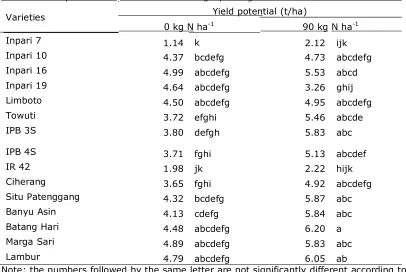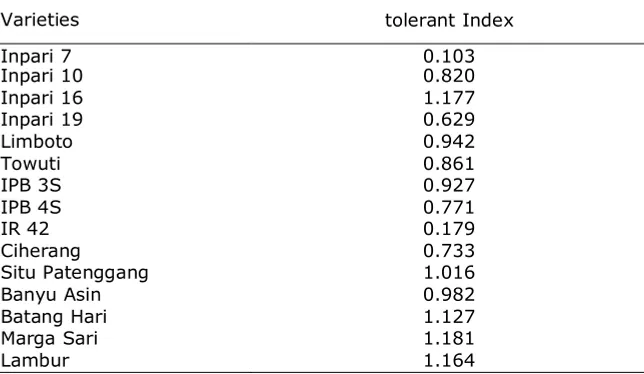147
Some Rice Varieties Tolerant to Nitrogen Deprivation
1*
Muhammad Hatta, 2Rosmayati, 2Chairani Hanum, and 2Hamidah Hanum
1
Graduate Student, Doctoral Study Program of Agriculture Science, University of Sumatera Utara, Indonesia
2Lectures, Study Program of Agroekoteknologi, Agriculture Faculty, University of Sumatera
Utara, Indonesia
*Corresponding Author: [email protected]
Abstract
A research on rice varieties tolerant to nitrogen deficiency has been conducted. The experiment was arranged in a split plot design with 3 replicates. There were 15 varieties of rice studied and 2 levels of nitrogen applied, i.e. 0 kg Nha
-1 and 90 kg Nha-1
. The results showed that rice varieties resistant to nitrogen deficiency were Inpari 16, Marga Sari, Lambur, Inpari 19, Limboto, and Batang Hari. However, rice varieties with high-tolerant to nitrogen deficiency were Marga Sari, Inpari 16, Lambur, Batang Hari, and Situ Patenggang.
Keywords: rice, variety, tolerance, nitrogen, deficiency, agronomic character
Introduction
World and Indonesia rice production have flourished. This has been thanks to high yield varieties produced since the Green Revolution. One of the characteristics of these high yield varieties is highly responsive to fertilization. However, we need to realize that this has double-sided nature; one side gives a higher rice yield, but on the other hand brings serious implications for the sustainability of rice farming in the future. One implication is that exceedingly high doses of chemical fertilizers have been applied in rice land farmers. This is mainly due to the fact that rice varieties developed today generally are "greedy" for fertilizers, especially nitrogen fertilizers.
The adverse effects of excessive use of chemical fertilizers in the long run will upset agricultural land, environment, and economy. Chemical nitrogen fertilizer continuously applied to soil will cause damage as a result of the loss of organic matter, soil compaction, increased salinity, and inorganic nitrate leaching (Cummings and Orr, 2010). In addition, chemical fertilizer nitrogen when fed in excess can lead to eutrophication of the river and coastal ecosystems as well as increased emissions of greenhouse gases such as nitrous oxide (N2O) (Vinod and Heuer, 2012). Excessive use of chemical fertilizers is also critical for the economy. In 2012, Indonesia is expected to spend 35 trillion rupiah for subsidized fertilizer, which is 18.5 trillion dollars paid by farmers and government subsidies of 16.9 trillion rupiah (Deptan, 2012).
Problems arising from "greedy" N fertilizer varieties are to drive future rice farming systems be based on varieties that are resistant and tolerant to nitrogen deficiency and more efficient in the use of nitrogen fertilizer. Resistant varieties are varieties that provide high yields under conditions of nitrogen deficiency, whereas tolerant varieties according to Fritsche-Neto and Do Vale (2012) are varieties that have a narrow productivity gap between the stress conditions to normal conditions. Moreover, efficient varieties are varieties that provide high rice yield per unit of nitrogen supplied (Witcombe et al., 2008).
Development of varieties that are resistant and tolerant to nitrogen deficiency requires a series of very complex plant breeding research and development activities. Progress towards these efforts is still very little. Selection of local and national rice germplasm is essential to obtain resistant and tolerant rice varieties to nitrogen deficiency. According to Bänzinger et al. (2000), the selection of appropriate germplasm is critical and requires careful consideration of all available information.
Materials and Methods
September 9-11, 2015, Banda Aceh, Indonesia
148
The experiment was arranged in a split plot design with 3 replications. Factors studied were varieties (V) and nitrogen (N). Variety was placed as the subplot and nitrogen as the main plot. Nitrogen
consisted of two levels: N0 = without nitrogen and N1 = 90 kg Nha-1 (195.65 kg Urea ha-1). Variety
consisted of 15 varieties.
Data were analyzed using anova followed by Duncan multiple range test at 5 percent and correlation analysis. The analysis was conducted by using statistical program of CoStat 6311, Minitab 14, and SPSS 19 (Munir, 2012; Minitab, 2004; SPSS, 2010; Santoso, 2012; Steel and Torrie, 1980; CoStat,
1998). Correlation between the characters was conducted by Pearson correlation analysis at α = 0.05
(Sokal and Rohlf, 1981).
Tillage was done using hand tractors, twice as deep as 20 cm, using a rotary plow. Then, the soil was left for 7 days (Jumin, 2010) so that the grass and organic matter were mixed with soil to decompose completely.
Seeds of 15 varieties were soaked in water for 24 hours. Then, the seeds were put in a plastic bag to be aerated for 48 hours. The germinated seeds, then, were moved to a nursery by evenly spreading them on seedling media. A nursery medium was a mixture of soil and compost (1:1) in perforated plastic trays.
Seedlings were transplanted in a square pattern with a spacing of 20 cm x 20 cm. Each variety was planted in three rows along 2 m. Space between the varieties was 40 cm. The seedling used was at age of 21 days after sowing. The number of seedling was one per hole. At the time of planting, water was in a state of shallow depth.
Nitrogen fertilizer dosages were given in accordance with the treatment, i.e. 0 and 90 kg N ha-1,
equivalent to 0 and 195.65 kg Urea (Deptan, 2007). Phosphate fertilizer was given in the form of
SP36 and K fertilizers in the form of KCl. Dosage of phosphate and K fertilizer given were 50 P2O5 kg
ha-1 and 50 K
2O kg ha-1, respectively (Hach and Nam, 2006), equivalent to 139 kg ha-1 of SP36 and
83 kg ha-1 of KCl.
The first application of N (25% dosage), P, and K fertilizing were carried out at age of 7 days after transplanting (DAT). The second N fertilizing (37.5% dosage) was done at age 25, and the third N fertilizing (37.5% dosage) was at the age of 40 DAT (Deptan, 2006). Fertilizer was given by way of spread. At the time of application of fertilizers, the water in the rice fields dried up to shallow depth.
149
Results and Discussion
Varieties Resistant to Nitrogen Deficiency
Data of yield potential of several national-high-yielding rice varieties are showed in Table 1.
Table 1. Yield potential of several national-high-yielding rice varieties
Varieties Yield potential (t/ha)
0 kg N ha-1 90 kg N ha-1
Inpari 7 1.14 k 2.12
ijk
Inpari 10 4.37 bcdefg 4.73
abcdefg
Inpari 16 4.99 abcdefg 5.53
abcd
Inpari 19 4.64 abcdefg 3.26
ghij
Limboto 4.50 abcdefg 4.95
abcdefg
Towuti 3.72 efghi 5.46
abcde
IPB 3S 3.80 defgh 5.83
abc
IPB 4S 3.71 fghi 5.13 abcdef
IR 42 1.98 jk 2.22 hijk
Ciherang 3.65 fghi 4.92 abcdefg
Situ Patenggang 4.32 bcdefg 5.87 abc
Banyu Asin 4.13 cdefg 5.84 abc
Batang Hari 4.48 abcdefg 6.20 a
Marga Sari 4.89 abcdefg 5.83 abc
Lambur 4.79 abcdefg 6.05 ab
Note: the numbers followed by the same letter are not significantly different according to DMRT at α =
0.05.
The results showed that yield potential of the varieties under study was varied, both in conditions without nitrogen fertilizer and with nitrogen fertilizers. At the conditions without nitrogen fertilizer, Inpari 16 gave the highest yield. In addition to Inpari 16, there were also several other varieties which show high yields. Among others were Marga Sari, Lambur, Inpari 19, Limboto, and Batang Hari. Varieties that gave the lowest yield were Inpari 7 and IR42.
By definition, varieties that provided high yields under conditions without nitrogen fertilizer was expressed as resistant varieties to nitrogen deficient. Therefore, Inpari 16, Marga Sari, Lambur, Inpari 19, Limboto, and Batang Hari can be regarded as resistant varieties.
Then again, yield potential in paddy fields with nitrogen fertilizer was also varied with a slightly different performance. Batang Hari gave the highest potential yield, followed by Lambur, Situ, Banyu Asin, Marga Sari, IPB 3S, and Inpari 16. Likewise, Inpari 7 also provided the lowest yield.
According to DMRT test, yield potential of each variety was not much different between nitrogen conditions. Almost all varieties showed results that were not significantly different between the two conditions, without nitrogen fertilizer and with nitrogen fertilizer. Exception was on the variety of IPB 3S, which showed that more yield potential under nitrogen fertilizer than under no nitrogen fertilizer
Varieties Tolerant To Nitrogen Deficiency
September 9-11, 2015, Banda Aceh, Indonesia
150
Table 2. Tolerant indices of national rice varieties
Varieties tolerant Index
Table 2 showed that tolerance indices of rice varieties above were very diverse, from 0.103 of Inpari 7 to 1.177 of Inpari 16. Basically, tolerance index gave an idea of the level of tolerance of a variety, in this case to nitrogen deficiency. The higher the index value of tolerance was, the higher the level of tolerance of a variety would be. From this understanding, then, Inpari 16 was much more tolerant to nitrogen deficiency than Inpari 7.
To make it easier, tolerant index could be categorized into five groups. The category was made based on all values of tolerant index obtained from this experiment. The category of tolerance index was belonged to the category of low and very low tolerances.
Conclusions
1. Varieties resistant to nitrogen deficiency were Inpari 16, Marga Sari, Lambur, Inpari 19, Limboto, and Batang Hari.
2. Varieties categorized as high tolerance to nitrogen deficiency were Marga Sari, Inpari 16, Lambur, Batang Hari, and Situ Patenggang. crop production graminaceous. In Plant Growth Promoting Bacteria and Health. D.K. Maheshwari (ed.). Microbiology Monographs 18, DOI 10.1007 / 978-3-642-13612-2_13, Springer-Verlag Berlin Heidelberg. Dartius, Djafar, Z.R., Aswad, M., Ardi, Sjofyan, Y., Hadiyono, Lakitan, B., Suryati, D., Hanolo, W., dan Sagiman, S.
1991. Plant Growth Analysis. Board of Western Universities Cooperation, Palembang.
Deptan. 2006. Fertilization for rice based on yield target. http://lampung.litbang.deptan.go.id/ind/images/stories/publikasi/padisawah.pdf. [13-10-2014].
Deptan. 2007. Reference of fertilizer recommendation for N, P, and K in specific wetland (per districts) as the attachment of Agriculture Ministry Regulation, number 40/Permentan/OT. 140/04/2007 about fertilizer recommendation for N, P, and K on rice at specific location. http://psp.deptan.go.id /assets/file/ 66d1189256a51f097c2863e1b0411107.pdf. [13-10-2014].
151
Infrastructure Directorate General of Agriculture, Agriculture Ministry. http://www.deptan.go.id/ pedum2012/ PSP/5.0.%20JUKLAK%20PUPUK%20BERSUBSIDI%202012.pdf. [8-3-2013].
Fritsche-Neto, R. and DoVale, J.C. 2012. Breeding for stress-tolerance or resource-use efficiency? In Plant Breeding for Abiotic Stress Tolerance. R. Fritsche-Neto and A. Borem (eds.), DOI: 10.1007 / 978-3-642-30553-5_2, © Springer-Verlag Berlin Heidelberg.
Gomez, K.A. 1972. Techniques for Field Experiments with Rice. International Rice Research Institute.
Hach, C.V and Nam, N.T.H. 2006. Responses of some promising high-yielding rice varieties to nitrogen fertilizer. Omonrice 14: 78-91.
IRRI. 2002. Standard Evaluation System for Rice (SES). International Rice Research Institute (IRRI). Jumin, H.B. 2010. Dasar-Dasar Agronomi. PT Raja Grafindo Persada, Jakarta.
Minitab. 2004. Minitab Realease 14 Statistical Software.
Munir, A.R. 2012. Application for Path Analysis Using SPSS Version 12. http://repository.unhas.ac.id/handle/123456789/870
Santoso, S. 2012. SPSS Application in Multivariable Statistic. PT. Elex Media Komputindo, Kompas Gramedia, Jakarta.
Sokal, R.R. and Rohlf, F.J. 1981. biometry. W.H. Freeman and comapany, New York. 2010. IBM SPSS Statistics SPSS version 19.
Steel, R.G.D. and.Torrie, J.H. 1980. Principles and Procedures of Statistics: A biometrical Approach. Second Edition. McGraw-Hill Book Company, New York.
Vinod, K.K. and Heuer, S. 2012. Approaches towards nitrogen- and phosphorus-efficient rice. PLANTS: pls028; doi: 10.1093 / aobpla / pls028.
Witcombe, JR, Hollington, PA, Howarth, CJ, Reader, S. and Steele, KA. 2008. Breeding for abiotic stresses for sustainable Agriculture. Phil. Trans. R. Soc. B. 363, 703-716. doi: 10.1098 / rstb.2007.2179

